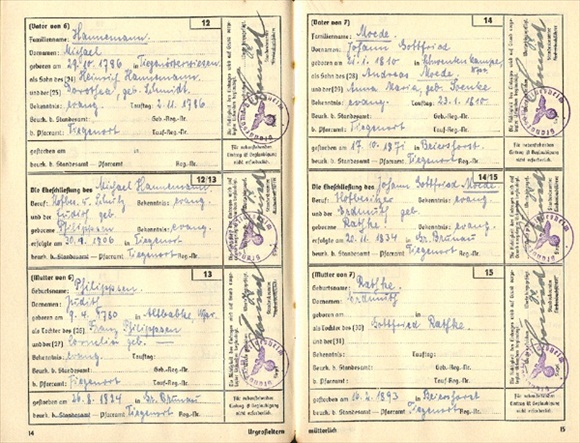REICHSTAG PASSES ANTI-SEMITIC LAWS
Berlin, Germany · April 7, 1933
Following his swearing in as chancellor on January 30, 1933, Adolf Hitler and his Nazi party began a policy of Gleichschaltung (synchronization), whereby Germany would be thoroughly reordered along Nazi lines. With the Reichstag’s passage of the Enabling Act on March 23, 1933, Hitler ruled by decree and the Nazi synchronization engine sprang to life. On this date in 1933 compliant Reichstag members passed the Civil Service Restoration Act, also known as the Aryan Act. This law reestablished “national” civil service and allowed tenured civil servants to be dismissed. Civil servants who had opposed the Nazis or who were not of pure Germanic descent (not “Aryans”; the term was defined the following week) were forced to retire. This meant that Jews and political opponents of the Nazis could not serve as teachers, professors, judges, or hold other government posts. Shortly afterwards a similar law was passed covering lawyers, doctors, tax consultants, and public notaries. Limits were placed on the number of Jews in public schools. In September and October Jews were excluded from working in cultural and entertainment occupations, as well as in the field of journalism. The raft of legislation culminated in the 1935 Nuremberg Laws “for the final separation of Jewry from the German Volk” (racial community). The areas of legitimate employment open to Jews (Voll-Juden) and “Jewish mixed-breeds” (Mischlinge) dwindled to nothing. For the most part ordinary Germans accepted anti-Semitic legislation without protest owing to their deep respect for the law and their acceptance of Nazi racist ideology, us versus them. The visible ostracism and persecution of Jews was ratcheted up with new legislation two years after Hitler had unleashed his genocidal war in Europe. From September 1941 the law obligated all Jews over the age of six, when out in public, to wear the Judenstern, or “Jewish star.” Fines or imprisonment were imposed on victims who broke the law or hid the star in any way. The next month rail cars left the Nazi capital for the east, the first in a series that carried thousands of Berliners to Jewish ghettos and labor and death camps in occupied territories. Between five and seven thousand Jewish Berliners avoided deportation by “diving” (tauchen) underground.
[amazon_carousel widget_type=”ASINList” width=”600″ height=”200″ title=”Recommended Reading” market_place=”US” shuffle_products=”False” show_border=”False” asin=”0786887737,0253349451,0674027388,0252061470,025207453X,1416594272,0801848245,0300188544,0061350273,0300151276″ /]
Two Documents that Attested to Non-Jewish Ancestry in Nazi Germany and Austria
 |
Above: An example of a Ariernachweis (Aryan Certificate), in this instance issued by the Stadtpfarramt Boennigheim in the state of Baden-Wuerttemberg. It certified that the person had no Jewish parents or grandparents. Beginning in April 1933 the Aryan Certificate was required of all employees and officials in the public sector, including education, under the Civil Service Act. Outside the civil service, the Act’s Aryan paragraph was inserted into the statutes of many federations, organizations, corporations, and real estate deeds, ultimately excluding Jews from all public life.
 |
Above: The pages in the Ahnenpaß (Ancestor Passport) documented the non-Jewish lineage of citizens of Nazi Germany and Austria. It was one of the forms of the Aryan Certificate. A proven Aryan lineage was required for working in the professions, attending high school or the university, owning real estate, and even getting married.
Short Clip of Hitler Speaking to the Reichstag Assembled on September 15, 1935, at the Nuremberg Party Rally. The Reichstag Enacted the Anti-Semitic Nuremberg Laws on the Same Day
![]()

 History buffs, there is good news! The Daily Chronicles of World War II is now available as an ebook for $4.99 on Amazon.com. Containing a year’s worth of dated entries from this website, the ebook brings the story of this tumultuous era to life in a compelling, authoritative, and succinct manner. Featuring inventive navigation aids, the ebook enables readers to instantly move forward or backward by month and date to different dated entries. Simple and elegant! Click
History buffs, there is good news! The Daily Chronicles of World War II is now available as an ebook for $4.99 on Amazon.com. Containing a year’s worth of dated entries from this website, the ebook brings the story of this tumultuous era to life in a compelling, authoritative, and succinct manner. Featuring inventive navigation aids, the ebook enables readers to instantly move forward or backward by month and date to different dated entries. Simple and elegant! Click 











